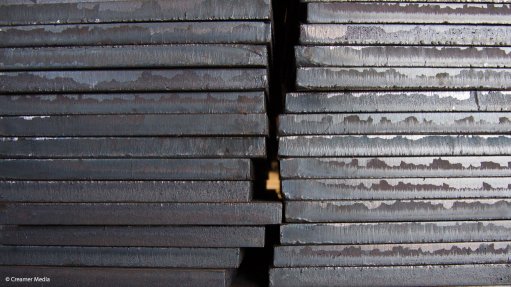
Photo by: Duane Daws
A slowdown in China’s demand for steel is set to restrain global steel industry growth over the next two years, the World Steel Association’s (worldsteel’s) latest Short Range Outlook (SRO) for 2015 and 2016 revealed on Monday.
Following a marginal 0.6% uptick in 2014, global apparent steel use was forecast to increase by 0.5% to 1.54-billion tonnes in 2015, before growing by 1.4% to 1.5-billion tonnes in 2016.
The Chinese government’s rebalancing efforts had led to a 3.3% contraction – the first since 1995 – in the country’s steel demand to 710.8-million tonnes in 2014.
The move to rebalance China’s economy had a major impact on the real estate market, the SRO explained.
“Chinese steel use will continue to record negative growth of -0.5% in both 2015 and 2016 [to 707-million tonnes and 703-million tonnes respectively]. In the medium term, no strong rebound is expected,” worldsteel economics committee chairperson Hans Jürgen Kerkhoff said, adding that some uncertainty remained around the impact of government measures aimed at stabilising the decelerating economy.
After posting low growth of 2.3% in 2014, owing to the continued deterioration in the Brazilian and Russian steel markets, steel demand in developing economies, excluding China, was expected to grow by 2.4% in 2015 and by 4% in 2016.
While 2015 was expected to see relatively weak growth overall, some economies, such as India, Indonesia, Vietnam and Egypt, where steel markets were still developing, would register positive growth.
Africa, which reported growth of 4.2% to 37-million tonnes in 2014, was expected to see demand grow by 7.4% to 40-million tonnes in 2015 before slowing by 4.9% to 42-million tonnes in 2016.
Growth in developed economies was expected to moderate in 2015 after a 6.2% jump in steel demand during 2014 on the back of strong US fundamentals and a firming European Union (EU) recovery.
Less favourable steel market environments in the US, Japan and South Korea, and a constrained recovery in the EU, owing to weak investment activity and high unemployment, would slow growth to 0.2% in 2015 and 1.8% in 2016.
“While we continue to face some downside risks coming from some parts of Europe – geopolitical instability, international capital flow volatility and the economic slowdown in China – the impact of these risks has come down,” Kerkhoff noted.
Further, there were “encouraging” developments of recovery momentum in the Eurozone, increased optimism surrounding India and growth in steel use in some Middle East and North Africa and the Association of Southeast Asian Nations member States.
“While these developments will not be enough to counterbalance the deceleration of China, we expect to see gradually improving growth prospects beyond 2016,” Kerkhoff concluded.